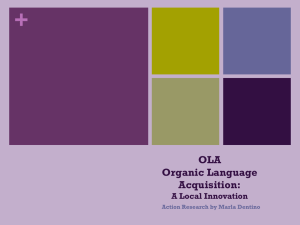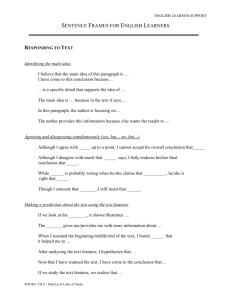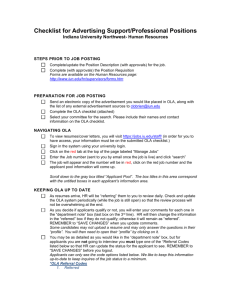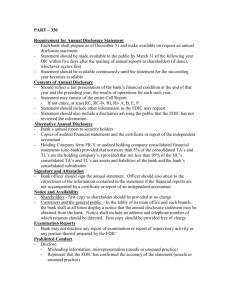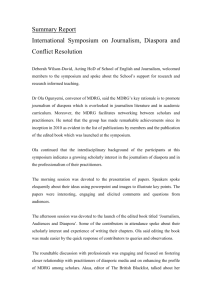OLA After SingLe POint Of entry: HAS AnytHing CHAnged? Stephen
advertisement
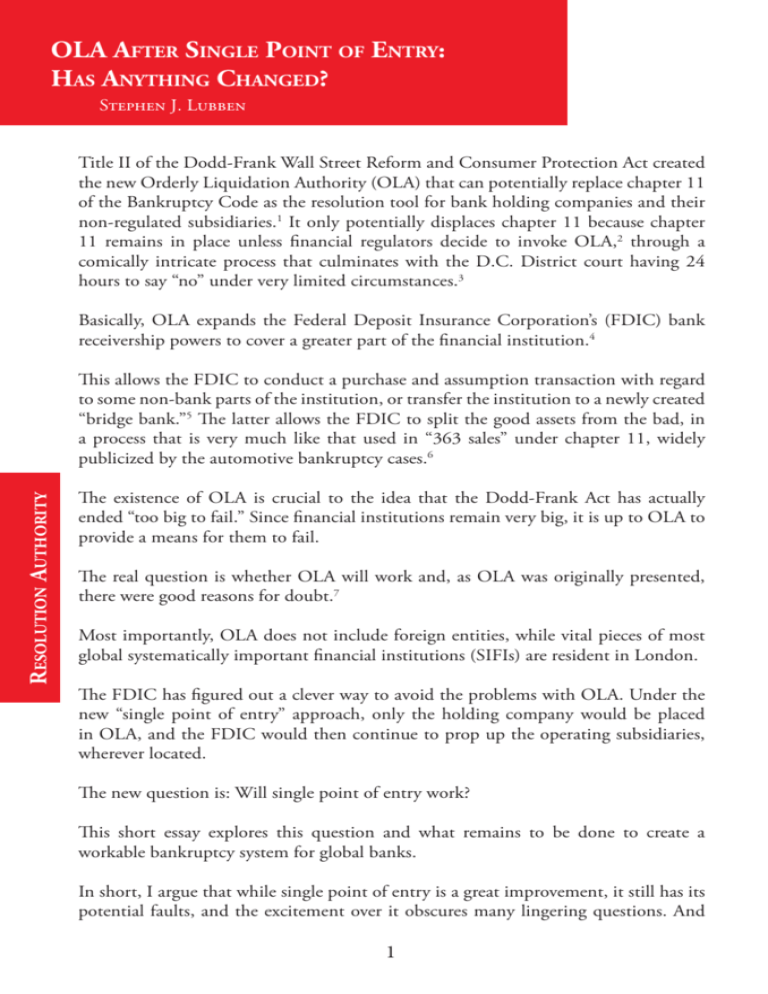
OLA After Single Point of Entry: Has Anything Changed? Stephen J. Lubben Title II of the Dodd-Frank Wall Street Reform and Consumer Protection Act created the new Orderly Liquidation Authority (OLA) that can potentially replace chapter 11 of the Bankruptcy Code as the resolution tool for bank holding companies and their non-regulated subsidiaries.1 It only potentially displaces chapter 11 because chapter 11 remains in place unless financial regulators decide to invoke OLA,2 through a comically intricate process that culminates with the D.C. District court having 24 hours to say “no” under very limited circumstances.3 Basically, OLA expands the Federal Deposit Insurance Corporation’s (FDIC) bank receivership powers to cover a greater part of the financial institution.4 Resolution Authority This allows the FDIC to conduct a purchase and assumption transaction with regard to some non-bank parts of the institution, or transfer the institution to a newly created “bridge bank.”5 The latter allows the FDIC to split the good assets from the bad, in a process that is very much like that used in “363 sales” under chapter 11, widely publicized by the automotive bankruptcy cases.6 The existence of OLA is crucial to the idea that the Dodd-Frank Act has actually ended “too big to fail.” Since financial institutions remain very big, it is up to OLA to provide a means for them to fail. The real question is whether OLA will work and, as OLA was originally presented, there were good reasons for doubt.7 Most importantly, OLA does not include foreign entities, while vital pieces of most global systematically important financial institutions (SIFIs) are resident in London. The FDIC has figured out a clever way to avoid the problems with OLA. Under the new “single point of entry” approach, only the holding company would be placed in OLA, and the FDIC would then continue to prop up the operating subsidiaries, wherever located. The new question is: Will single point of entry work? This short essay explores this question and what remains to be done to create a workable bankruptcy system for global banks. In short, I argue that while single point of entry is a great improvement, it still has its potential faults, and the excitement over it obscures many lingering questions. And 1 nothing has been done to improve the ability of chapter 11 to handle a large financial institution, despite the fact that OLA is only supposed to “backstop” the normal bankruptcy process. Single Point of Entry The FDIC’s new approach under OLA—the single point of entry plan—focuses entirely on ensuring the holding company can absorb the organization’s losses, including those sustained by its operating subsidiaries. Single point of entry is rooted in the undeniable premise that holding company claimants are less “runnable” than operating company claimants. Shareholders and bondholders might sell their holdings, depressing the market price, but that does nothing to withdraw liquidity from the financial institution. Thus the FDIC would save the enterprise by taking control of the holding company, eliminating existing claimants of that company, and selling new equity in the holding company to recapitalize it. While this process is pending, financing from the FDIC under the provisions of OLA would keep the holding company—and its worldwide operating subsidiaries—afloat. The Dodd-Frank Act does provide the FDIC with the power “to enforce contracts of subsidiaries or affiliates of the covered financial company, the obligations under which are guaranteed or otherwise supported by or linked to the covered financial company.”8 It is not clear what it means for the holding company to enforce a derivative that it is not directly a party to, but the FDIC has used this as the basis for rules that prohibit termination of a derivative because of the OLA filing of a parent company.9 At least superficially, this seems to address a key lesson learned during the Lehman Brothers bankruptcy. In short, single point of entry is a marked improvement over OLA as originally envisioned. It offers the prospect of saving a financial institution as a going concern, whereas the drafters of the Dodd-Frank Act seemed to see it as a method for liquidating the financial institution’s domestic parts, while leaving the foreign bits to their fate. 2 Resolution Authority In the case of Lehman Brothers, the filing of the holding company several weeks before the operating subsidiaries brought to the fore the reality that while most derivative transactions might be entered into by operating companies, by their terms the contracts provide that the failure of a “credit support provider” (i.e. the holding company) triggers an immediate right to terminate the trade. Unfortunately, if we push beyond the happy press releases trumpeting the wonder of single point of entry, we see that questions remain. For example, it is not clear that the FDIC’s solution to the derivatives problem will hold up if challenged. How does the FDIC get the power to prevent the termination of a contract between two parties, neither of which is in OLA? Congress might exercise such a power under the Commerce Clause, but when done by rule on the basis of a confused piece of statutory text, the risk of litigation looms large. Whatever the merits of that litigation, it has serious potential to gum up an OLA proceeding. Resolution Authority More broadly, while it is certainly theoretically true that the pain of financial distress falls first on bank shareholders, then on bank bondholders, then on uninsured depositors, and so forth, reality might be somewhat different. Recent events have made that quite clear. First note that while terminating existing stakeholders might be preferable to the 2008 model—where stakeholders were, at worst, diluted in every case other than Lehman Brothers—it does nothing to address the distressed SIFI’s immediate problems. Indeed, returning the SIFI to solvency is of minor importance compared to refurbishing its liquidity. Nevertheless, much of the discussion of single point of entry, and regulation in general, has focused on the question of solvency. A SIFI might have ample capital, but face a liquidity shortfall. Indeed, the classic bank run of Jimmy Stewart fame does not depend on a rational assessment of the balance sheet, but rather comes from a panic that drains the institution’s liquidity, leaving it in breach of its obligations while still possessing more assets than liabilities. Before the Dodd-Frank Act, the Federal Reserve’s section 13(3) powers provided an obvious solution here, but since the power is now limited to programs of “broadbased eligibility,” it may no longer be quite as useful in the case of a single institution facing a run. Indeed, the Federal Reserve now is expressly prohibited from lending under this section for the “purpose of assisting a single and specific company avoid bankruptcy, resolution under title II of the Dodd-Frank Wall Street Reform and Consumer Protection Act, or any other Federal or State insolvency proceeding.” This limitation may compromise the Federal Reserve’s ability to address such a liquidity crunch before it reaches the systemic level. Recapitalization of the institution under OLA might solve the SIFI’s long-term liquidity needs, but successful recapitalization is going to depend on the value of the enterprise. That value will be largely a function of the value of the SIFI’s subsidiaries, 3 perhaps with a little premium that reflects the synergies of having all those subsidiaries working together under a single roof. If that value is no longer sufficient to support the capital the financial institution needs, the FDIC will face a real problem. Either losses will have to be imposed at the subsidiary level to cut the SIFI down to size or the FDIC will simply have to inject value into the institution. The latter looks suspiciously like a bailout in all but name, while the former undermines the benefits of single point of entry, which is not supposed to touch the operating companies. Recall that the Dodd-Frank Act still requires the liquidation of a failed financial institution.10 The FDIC has converted that requirement into the liquidation of the holding company, not quite the same thing. Preserving the institution as a going concern might be wise from both a regulatory and creditor recovery perspective, but one has to wonder if it is totally faithful to the congressional charge. Using liquidity provided to the parent company to stave off the failure of non-liquidated subsidiaries also pushes again the command that “[n]o taxpayer funds shall be used to prevent the liquidation of any financial company under this subchapter.”11 In short, inflicting pain on holding company stakeholders also does nothing to address the financial institution’s immediate liquidity needs. This is where the DoddFrank Act’s lending mechanism between the U.S. Treasury and the FDIC would come in, but it is easy to imagine such lending quickly could become a stealth bailout of subsidiary creditors. The FDIC will note that any funding it provides will be secured by a priority lien on the debtor’s assets. But since the holding company’s only assets will be shares in the operating subsidiaries, this will create a kind of cyclical need for FDIC financing. To preserve the value of its collateral, the FDIC will need to meet any and all funding requirements of the subsidiaries if single point of entry is to work as advertised. In the case of a global SIFI, it would be easy to imagine that this number could become quite large, quite quickly. In a systemic crisis, the FDIC might be making many such loans. The FDIC argues that once it takes charge, “because the group remains solvent, retail or corporate depositors should not have an incentive to ‘run’ from the firm under resolution insofar as their banking arrangements, transacted at the operating company level, remain unaffected.”12 4 Resolution Authority This also highlights the degree to which single point of entry depends on the existence of a problem that is easily isolated. A general collapse of a SIFI, across multiple business units, is not what the FDIC is interested in discussing at the moment. Assuming rationality in a financial crisis is a doubtful solution to a difficult problem. Given the obvious fragility of the wholesale funding market, and the lack of any real change to that market since the bankruptcy of Lehman Brothers, assuming that counterparties will continue business as usual while the parent company is undergoing an untested OLA proceeding seems somewhat cavalier. The FDIC might as well assume it will never have to use OLA if we are going to rely on these sorts of deus ex machina solutions. Resolution Authority Regulators might require the holding company itself stand ready to provide liquidity to the subsidiaries in times of stress. Of course, not only would this be quite expensive from a cost of capital perspective—the holding company would be investing shareholder funds in something akin to a T-bill portfolio, if we want to be sure the liquidity will be available in times of stress—but any such source of liquidity would presumably be tapped before OLA was invoked, assuming that OLA is truly to be a mechanism of last resort. To a similar effect are the proposals that call for some portion of the holding company’s debt to take the form of subordinated or contingent convertible debt. Converting debt to equity, or simply “vaporizing” it, provides a small liquidity boost equal to, at most, six months worth of interest payments.13 Unless this tranche of debt is quite large—which is not totally consistent with the broader regulatory agenda of reducing leverage—it seems unlikely that this newfound cash could make or break a teetering financial institution. Indeed, any benefit would also have to be offset against the negative signal that such a conversion would send to the market. The FDIC does have the ability to recoup unpaid lending from other SIFIs, but even under the best-case scenario this means some risk to taxpayers during the gap between the rescue of a distressed SIFI and the assessment of the others. Since the gsap could be as long as 10 years, the concern is not easily dismissed. Even if the money is fully paid back, the access to such funding is itself a privilege that most businesses do not enjoy. For example, when Circuit City faced bankruptcy, it was forced to take the only loan that the market would offer. That loan, which provided a very short window for reorganization, was a key reason why the company ultimately liquidated. Giving special privileges to banks might be inevitable, since SIFI failure is so disruptive, but if the risk of bailout remains, the justification for up front regulation that might avoid failure becomes even stronger. It’s relatively easy to rail against “moral hazard” in the abstract, and say that large financial institutions should be left to face “market forces,” such as insolvency and liquidation. But the financial system exists so that those with money to lend can get 5 that money to those who need it, and there are real consequences of allowing that system to fall apart. For example, The New York Times recently reported that Goldman Sachs controls about a quarter of the aluminum in the United States. Much of that metal belongs to other companies, but what would happen to countless U.S. manufacturers if that aluminum suddenly became entangled in a liquidation? The Bank of New York Mellon Corporation reports on its own website that “[a]s of June 30, 2013, BNY Mellon had $26.2 trillion in assets under custody.” That is, it is holding more than $26 trillion of assets that belong to other people. There is no way to allow this firm to liquidate or face “market forces” that will not have serious effects on the owners of those assets. On its website, Bank of America explains that: If Bank of America faces “market reality” someday, all of these customers will feel the pain too. In the face of those real consequences, it is probably best to acknowledge that large financial institutions will be bailed out in some circumstances. Probably the better goal is to make sure that those bailouts are paid for in advance, by the entities that are most likely to need them. Single point of entry itself does nothing to address that core goal. Much continues to rest on pre-failure prudential regulation and the ability of regulators to avoid the need to ever use OLA. The Chapter 11 Backstop The OLA option is meant to be used rarely and only in those unexpected circumstances where a financial institution’s failure and resolution under the Bankruptcy Code would have adverse ramifications for U.S. financial stability and only where a finding to that effect is made at the most senior levels of the Treasury Department, the Federal Reserve, and the FDIC. That would seem to require a viable alternative, since the Bankruptcy Code was found lacking in cases like American International Group (AIG). Yet no efforts have been made to modify the Code. 6 Resolution Authority We serve approximately 51 million consumer and small business relationships with approximately 5,300 retail banking offices and approximately 16,350 ATMs … Bank of America is among the world’s leading wealth management companies and is a global leader in corporate and investment banking and trading across a broad range of asset classes, serving corporations, governments, institutions and individuals around the world. To provide a workable alternative to OLA, what would the Code need? The conversation must begin with equalizing the treatment of derivatives under the Bankruptcy Code with that under OLA. That means at least a short stay on the closeout of positions, and also a prohibition on the enforcement of “walk away” clauses, which give an extra incentive to terminate. OLA provides that “walk away” clauses—which allow the non-debtor party to terminate without paying damages—are unenforceable. OLA also provides a onebusiness day stay on the termination of derivatives. The Bankruptcy Code should provide at least as much. A stay on the termination of contracts guaranteed by the parent company, when the non-debtor subsidiary otherwise continues to perform, would also bring the two systems into alignment. Resolution Authority Speed is another advantage that OLA offers over chapter 11. The Lehman Brothers sale took place within a week of the chapter 11 filing. It seems safe to assume that this is the outer limit of how quickly a sale might happen under the Bankruptcy Code. Some judges might not be willing to move that fast, especially outside the context of a financial crisis. The Code should make clear that sales conducted at high speed are not only permissible but desirable when they involve large financial institutions. At the same time, debtor institutions must have the ability to stabilize their business during the chapter 11 process. In some instances, normal debtor-in-possession financing under section 364 of the Code will do the trick, but not if the financial institution is too big, or fails during a credit crunch. In these sorts of cases, the SIFI in chapter 11 should at least have access to the same FDIC financing that would be available in an OLA proceeding, with similar controls and payback requirements. There is also a need to expressly allow the SIFI’s regulators to participate in the proceedings. This begins with giving the regulators, or at least a primary regulator, the right to file an involuntary bankruptcy petition, but continues to provide the regulator with a voice in all other key aspects of the case. Moreover, the bankruptcy court must have authority to consider the larger context when a financial institution enters chapter 11. For example, if a particular action would be beneficial to creditors, but systemically dangerous, it is not clear under current law that the court could deny the requested relief. 7 On the specific point of the bankruptcy judges, it is also vital that Congress address the uncertainty regarding those judges’ power and authority following the Supreme Court’s decision in Stern v. Marshall.14 This confusion, although damaging to all aspects of the bankruptcy system, is particularly troublesome in the context of a SIFI failure. Once the bankruptcy court begins the process of resolving a financial institution, its actions must not be subject to doubt and question. Endnotes 1. 12 U.S.C. §§ 5381-94. 2. 12 U.S.C. § 5382(c)(1); see 12 USC §§ 5388, 5383(b)(2). Stephen J. Lubben, Transaction Simplicity, 112 Colum. L. Rev. Sidebar 194, 199 (2012). 3. 12 U.S.C. § 5382; see also 12 USC § 5383. 4. 12 U.S.C. § 5384(b). See Brett McDonnell, Don’t Panic! Defending Cowardly Interventions During and After A Financial Crisis, 116 Penn St. L. Rev. 1, 49 (2011). 5. 12 U.S.C. § 5390. 6. Stephen J. Lubben, No Big Deal: The GM and Chrysler Cases in Context, 83 Am. Bankr. L. J. 531 (2009). See also Stephanie Ben-Ishai & Stephen J. Lubben, Sales or Plans: A Comparative Account of the “New” Corporate Reorganization, 56 McGill L.J. 591 (2011); A. Joseph Warburton, Understanding the Bankruptcies of Chrysler and General Motors: A Primer, 60 Syracuse L. Rev. 531, 568 (2010). 7. Stephen J. Lubben, Resolution, Orderly and Otherwise: B of A in OLA, , 81 U. Cin. L. Rev. 485 (2012). 8. 12 U.S.C. § 5390(c)(16)(A). 9. 12 C.F.R. § 380.12. 10. 12 U.S.C. § 5394. 11. 12 U.S.C. § 5394(a). 12. http://www.fdic.gov/about/srac/2012/gsifi.pdf 13. Interest on corporate debt issued in North America is typically paid biannually. 14. 131 S. Ct. 2594 (2011). 8 Resolution Authority Stephen J. Lubben Stephen J. Lubben, holder of the Harvey Washington Wiley Chair in Corporate Governance & Business Ethics at Seton Hall University School of Law, is an internationally recognized expert in the field of corporate finance and governance, corporate restructuring, financial distress and debt. He is the author of a leading corporate finance text, and a contributing author to the new Bloomberg Law on Bankruptcy treatise. He is also the In Debt columnist for the New York Times’ Dealbook page, and a contributor to Credit Slips, a blog started by a small group of bankruptcy experts.
